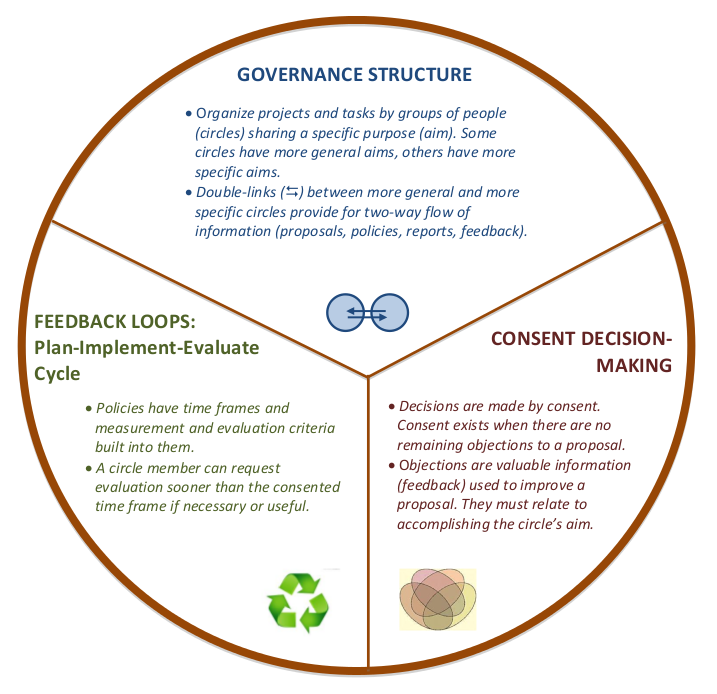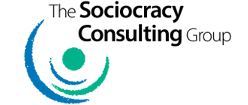How it Works

The Sociocratic Circle-organization Method (SCM - sometimes called Dynamic Governance in the USA) is based on a simple, elegant set of principles that provide a solid foundation for effective, transparent governance and decision-making. These principles are:
- Consent - policy decisions are made by consent. Consent means there are no objections to a policy. Objections are seen as valuable feedback that will help improve a proposed policy. Objections arise when a proposed policy conflicts with the organization's mission and aims, or with a role within the organization. Objections can be clearly explained to all involved, even if not all agree with the objection.
- Circles - a circle is a semi-autonomous, self-organizing entity within an organization - like a division, department, team, working group, and so on. Circles meet to determine policies in their domain of responsibility, using consent decision-making. Circles reflect operational structure, and include all roles and activities within an organization.
- Double Linking - provides multi-directional feedback. Effective feedback paths are provided by double-linking - two people who are full members of both linked circles. This enables policy-making that reflects the needs of all those affected by a decision.
In addition there are three foundational values in the SCM:
- Equivalence - when making policy decisions to guide their work, members of the organization function as peers.
- Transparency - members of the organization have direct access to the information they need to make high quality decisions in their areas of responsibility and accountability.
- Effectiveness - the organization and its members consistently practice self-improvement through measurement, feedback and evaluation, to support ongoing and increasing effectiveness of the organization.
Applications of these principles and values produce exceptionally resilient, adaptable, and productive organizations. Applications include but are not limited to:
- Elections - circles elect people to functions, tasks and roles by consent and with transparency. Elections are essentially selection by consent.
- Membership - Adding or removing members of a circle.
- Role reviews - for circle members, by their colleagues in the organization.
The policies that guide an organization in realizing its vision are created through applications of these foundational principles.
A Brief History
Beginning around 1970, Gerard Endenburg developed an organizational management and governance method called the Sociocratic Circle-organization Method (SCM), while managing his electrical engineering corporation, Endenburg Electrotechnik, in the Netherlands. The theoretical and philosophical basis for the SCM was sociocracy, meaning governance by the socios - colleagues, associates, companions, a group with some common social relationship.
As an engineer, Endenburg was educated in the physical sciences and found the art of management to be unclear and unproven in its ability to create a harmonious and productive workplace. Building on his own experiences and education as well as related work by others, and using his company as a laboratory, he experimented by applying the principles of cybernetics - the science of communications and control - to the management of his business. In the process, he developed a unique method of organization.
The SCM is also known as Dynamic Governance, reflecting the method’s roots in system dynamics, cybernetics and systems design. These disciplines are ingeniously combined to create a comprehensive and elegant feedback system that guides decision-making and governance. This optimizes an organization’s ability to respond to internal and external pressures while maintaining security and stability.
Just as principles of system dynamics apply to all systems, the SCM can be applied, with suitable variations, to all organizations. It clarifies missions and goals and provides benefits that are specific to the environment in which it is implemented.
